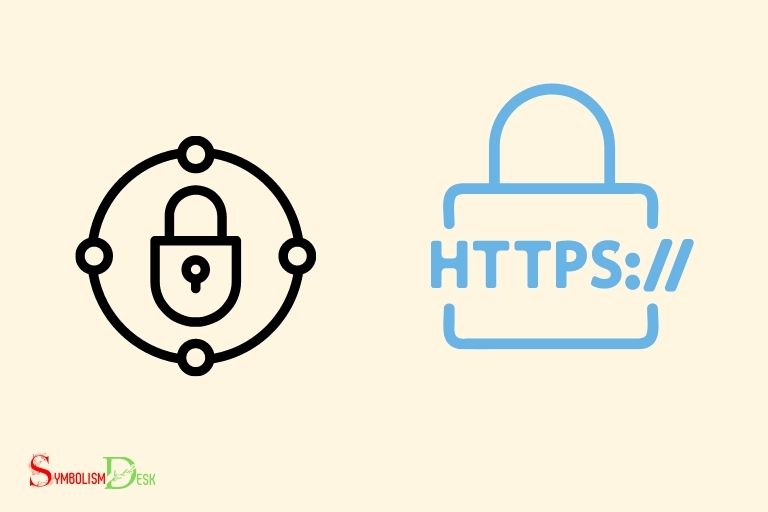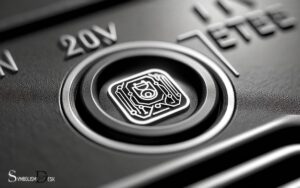Does the Lock Symbol Mean on Website? Secure!
The lock symbol on a website indicates that the site is secure and uses an encrypted connection for transmitting data.
When you visit a website, your browser sends a request to the site’s server, and the server responds with the website’s content.
To protect the data exchanged between your browser and the server, websites use a security protocol called Secure Socket Layer (SSL) or Transport Layer Security (TLS).
The lock symbol appears when a website uses these secure connections, ensuring that any sensitive information you share is encrypted and preventing unauthorized access.
When browsing the internet, always look for the lock symbol in your browser’s address bar to ensure you are visiting a secure site.
This icon signifies that the website is using SSL/TLS encryption to keep your data safe from potential threats, such as identity theft or fraud.
While the lock symbol helps protect your sensitive information, it is crucial to remember that it does not guarantee the website’s legitimacy.
It is still essential to verify the website and use common sense before trusting it with your personal information.
Benefits of Using a Lock Symbol on a Website
| Lock Symbol on Websites | Meaning | Benefits |
|---|---|---|
| Yes (Padlock) | Secure connection (HTTPS) | Data encryption, privacy, authenticity |
| No (No padlock) | Insecure connection (HTTP) | None |
| Broken (Padlock) | Partially secure or mixed content on the website | Limited security |
Key Takeaway

Five Facts About Lock Symbol Mean On Website
What Is The Lock Symbol And Why Is It Important?
Does The Lock Symbol Mean On Website
With the worldwide web being the backbone of modern communication and business, it is vital to ensure that users’ information is safe from theft.
One way of achieving this is through the use of a lock symbol. In this blog post, we will explore the significance of this symbol in providing security to your data.
Definition And Significance Of The Lock Symbol
The lock symbol appears on the left side of websites’ urls or at the bottom of the browser window. This padlock icon, also known as secure socket layer (ssl) certification, symbolizes that a website is secure and has the necessary protection to protect your information from theft.
The ssl certification ensures that the website encrypts all data transmitted to and from the server, making it unreadable to hackers.
The lock symbol plays a significant role in ensuring secure communication between your browser and the website you are visiting.
Here are some ways the lock symbol provides security and encryption to your data:
The lock symbol is a crucial security feature when browsing the internet. It provides authentication, encryption, and data integrity, protecting your information from prying eyes.
As a user, you should always look for the lock symbol before entering your sensitive information on a website.
What Are The Different Types Of Lock Symbols?
Have you ever wondered what the little lock symbol means on websites? If you’re like most internet users, you’ve probably seen it many times before but aren’t sure what it represents.
In this section, we’ll explore the different types of lock symbols you may come across while browsing the web, and what they signify for your online security.
Explanation Of Padlock Symbol
The padlock symbol is a common sight in your web browser’s address bar. It represents a secure connection between your computer and the website you’re visiting.
Here’s what you need to know about the padlock icon:
- The padlock indicates the website is using an https protocol to securely transfer data.
- Https stands for hyper text transfer protocol secure. It encrypts your data as it moves from your computer to the website’s server.
- Websites that use https are less susceptible to man-in-the-middle attacks, where someone intercepts your communication with the site to hijack your data.
Explanation Of Https (Hyper Text Transfer Protocol Secure) Symbol
You may have seen the letters “https” in the address bar of websites before. This is another type of security symbol that indicates a website is using a secure connection.
Here’s what you need to know about https:
Differences Between The Padlock And Https Symbols
Though the padlock and https symbols both represent secure web connections, there are some key differences to note:
Overall, seeing either the padlock symbol or the https symbol in your browser’s address bar is a good sign that the website you’re visiting is taking appropriate measures to protect your data.
Security
Why Checking For The Lock Symbol Is Important For Your Online Security
When you browse the internet, you may have come across a small padlock symbol located near the website’s URL.
This padlock symbol is known as the “lock symbol” and represents an important yet straightforward feature that you should pay attention to.
In this section, we’ll discuss why checking for the lock symbol is crucial for your online security.
The lock symbol represents a secure website
When you browse the internet, security should be one of your top concerns. The lock symbol signifies that a website utilizes ssl encryption, ensuring that any data transferred between your computer and the website remains private and secure.
Unsecured websites pose a significant threat
When you visit an unsecured website without the lock symbol, any data you provide on that website (such as login credentials, credit card information, or more) are vulnerable and at risk of being intercepted.
This puts your private information in danger of being stolen and misused, potentially leading to identity theft and fraudulent activities.
Cybercriminals can easily exploit unsecured websites
Hackers can exploit vulnerabilities in unsecured websites, tricking users into sharing their information through phishing scams, malware, or other tactics.
To avoid falling victim to these prying cybercriminals, it’s crucial to always check for the lock symbol when visiting a website.
Examples of security breaches and data theft
There have been several high-profile cases of security breaches, cyber-attacks, and data theft due to unsecured websites. Some significant examples include:
- In 2017, Equifax, one of the largest credit bureaus in the united states, suffered a data breach that exposed sensitive information of over 147 million customers.
- In 2018, Facebook disclosed that nearly 50 million user accounts were exposed in a data breach.
- In 2020, Easyjet, a uk based airline company, reported a data breach that exposed sensitive information of over 9 million customers.
By checking for the lock symbol, you can ensure that you are browsing safe and secure websites without putting your personal information at risk. Take cybersecurity seriously and always check for the padlock symbol in your web browser to ensure that you have a safe browsing experience.
Data Protection
How The Lock Symbol Helps In Protecting Sensitive Information
The lock symbol, also known as the ssl (secure sockets layer) certificate, is a vital feature of any website that handles sensitive information.
The ssl certificate secures internet connections and establishes encrypted links between a web server and a browser.
Here are some ways in which this certificate helps protect sensitive information:
- Authentication: The ssl certificate authenticates the website’s identity, ensuring that users are navigating on the correct platform and not a fraudulent one.
- Encryption: It encrypts the data exchanged between the user’s browser and the web server, preventing cybercriminals from intercepting and accessing sensitive information.
- Integrity: Information transmitted via an ssl connection maintains its integrity, meaning it cannot be altered during the transfer process.
Importance Of Data Protection
Data protection is the practice of safeguarding sensitive information from unauthorized access, use, alteration, or destruction. In today’s digital age, data protection is crucial to ensure the safety and security of users’ data.
Here are some reasons why data protection is essential:
- Consumer trust: As businesses collect and store a vast amount of consumer data, customers expect that their data is secure and will not be misused. Ensuring data protection builds trust and enhances a company’s reputation.
- Regulatory compliance: Data protection is a crucial part of regulatory compliance for businesses. Failure to comply with regulations can result in hefty fines or legal action against the business.
- Competitive advantage: Companies with robust data protection measures have a competitive edge as they are more likely to retain customers and attract new ones.
- Business continuity: Data loss or breach can be catastrophic for any business. Ensuring data protection reduces the likelihood of such a scenario, ensuring seamless business continuity.
The lock symbol plays a crucial role in protecting sensitive information and keeping users’ data secure.
It is essential to prioritize data protection for companies to build customer trust, comply with regulatory requirements, gain a competitive advantage and ensuring business continuity.
Identifying A Secure Connection
Overview Of How To Identify A Secure Connection Using The Lock Symbol
When browsing the internet, you may have noticed a small lock symbol in the address bar of your browser.
This lock symbol indicates that a website has a secure connection. But what does this mean? And how can you identify if a website has a secure connection?
In this section, we will be covering the key points on how to identify a secure connection using the lock symbol.
Checking The Lock Symbol
The lock symbol is an important indicator when browsing the internet because it tells you whether the website you’re visiting is secure or not. When you see the lock symbol in the address bar, it means that the website is using HTTPS protocol, which encrypts the data being transmitted between your computer and the website’s server. This helps protect your personal information from being intercepted by hackers. If you don’t see the lock symbol, it’s best to avoid entering any sensitive information on that website, especially if you’re making a purchase or providing personal details.For example, if you’re trying to troubleshoot a fixing ipad rotation issue, it’s important to make sure you’re on a secure website before seeking out any tech support or solutions. By being mindful of the lock symbol, you can help keep your information safe while browsing the internet.
Here’s how you can check for the lock symbol:
- Look for a lock symbol in the address bar of your browser, usually located to the left of the website’s URL.
- Check whether the lock symbol is closed. If it is, this indicates that the website has a secure connection.
- Check if the lock symbol is red or green. A green lock symbol indicates that the website has a valid ssl certificate and a secure connection.
- If the lock symbol is absent, has an open padlock or if it’s red, the website may not have a secure connection.
Checking For The Https Protocol
In addition to checking for the lock symbol, you can also check whether a website has a secure connection by looking for the https protocol in the website’s URL.
Here’s how you can do this:
Identifying a secure connection using the lock symbol can save you from potential online threats. Always check for the locked symbol in the address bar and look for the https protocol in the website’s url to ensure that you’re browsing securely.
Common Browsers And Devices
How To Check For The Lock Symbol On Popular Web Browsers (Chrome, Firefox, Safari, Opera)
Whether you are shopping for products online, filling in personal details on forms, or simply browsing the web, it’s vital to take note of your safety and security when using the internet.
One of the most significant ways to ensure your online security is by looking out for the lock symbol on your browser’s address bar.
Here is a step-by-step guide on how to check for the lock symbol on popular web browsers using markdown format:
Google Chrome
- Open google chrome on your device
- Find the site you wish to visit and go to its address by typing in the url
- Look for the lock symbol on the left side of the address bar.
If the icon appears locked, the website is secure, however, if it appears unlocked, the website may have security issues.
Firefox
- Open firefox on your device
- Input the website url you want to visit
- Locate the padlock icon on the left-hand side of the address bar.
If the icon appears green and locked, the site is safe, but if it’s unlocked or has no padlock, be wary, as this might lead to phishing attacks, malware, or cyber threats.
Safari
- Launch safari on your device
- Visit the website you are interested in
- Look at the left of the address bar for a lock symbol.
If the icon appears locked, it shows the website is secure, but if it’s unlocked, you might be looking at a phishing website or another type of security issue.
Opera
- Open opera on your device
- Type in the website url of interest
- Search to the left of the address bar for a padlock icon
- If the icon appears to be locked and green, it implies that the site is trustworthy and particularly safe.
If it’s locked but remains grey, the website might have some minor security issues that need attention. However, if the padlock is missing or unlocked, there might be potential problems with online security.
Instructions On Different Devices (Pc, Laptop, Mobile Devices)
Your browsing security doesn’t just depend on the browser. It also arises from the device you use. Whether you’re using a pc, a laptop or a mobile device for browsing, you need to ensure that your device is protected.
Here’s what you can do to ensure your safety across multiple devices:
Pc
- Use an antivirus software
- Update your browser regularly
- Only visit websites that you can trust
- Keep a plug-in that can detect phishing scams
- Avoid clicking suspicious links online
Laptop
- Always lock your laptop and ensure that it has a strong password
- Install software for spyware detection
- Turn off your wi-fi or disconnect from the internet when not in use
- Avoid downloading files from suspicious sources
- Be prudent with hyperlinks and use only reputable sources
Mobile Devices
- Keep your mobile device up to date with the latest software patches and updates
- Don’t install apps from unrecognised sources
- Watch out for public wi-fi networks and avoid accessing sensitive data
- Use a screen lock or password to secure your device
- Choose secure passwords and never use the same password across multiple services
That’s all for now. Remember to always verify the lock icon when browsing as this is crucial for maintaining your online security.
Security Risks And Concerns
What Happens When You Don’T See The Lock Symbol
When you visit a website, you may or may not notice a lock symbol on the top left corner of your browser’s url search bar. This green padlock symbol indicates that the website has an ssl (secure sockets layer) certificate.
It ensures that the information you provide, such as passwords, credit card details, and other personal data, are encrypted and secure. Without this lock, your data may be at risk of interception by hackers.
Risks Of Sharing Secure Information Without The Lock Symbol
It goes without saying that sharing secure information without the lock symbol means that your data is not protected.
Here is a list of some significant risks associated with not seeing the lock symbol on a website:
- Cybercriminals may intercept your data: Unsecured websites may allow hackers to intercept data sent between your browser and the server, such as passwords, credit card numbers, and personal information.
- The website may not be legitimate: Unsecured websites with no lock symbol could be fraudulent. Without any ssl certification, this means that they are not trusted, and your personal information may be utilized for nefarious purposes such as identity theft.
- Search engines don’t trust unsecured websites: Google and other search engines don’t trust websites without an ssl certificate, and this could considerably affect their ranking. Consequently, your website’s traffic might drop since google favors websites that secure user information.
- Browsers warn about insecure websites: Most browsers will warn users by displaying an “insecure connection” message if a website is not protected. Thus, you risk having your users leave your website, never to return.
When it comes to keeping your data safe online, an ssl certificate is an absolute must. It ensures that your sensitive information remains private, and unscrupulous hackers won’t have easy access to your data.
Therefore, it’s important to always check if a website has the lock symbol before entering any sensitive information.
How To Proceed In Case Of Insecure Connection
What Is The Lock Symbol On Website?
The lock symbol on websites indicates that the website is secure and using a hypertext transfer protocol secure (https) connection.
The https connection encrypts the data transmitted between the user’s browser and the website’s server, ensuring that sensitive information is kept confidential and secure.
This is especially important for websites that handle personal or financial information, such as bank websites and e-commerce platforms.
An insecure connection, on the other hand, means that the website is not using a secure https connection.
This puts the user’s confidential data at risk of being intercepted by third-party sources, leaving them vulnerable to cyberattacks and fraudulent activities.
If you encounter an insecure connection, here’s what you should do:
Checklist Of Actions To Take In Case The Lock Symbol Is Missing
- Check the url: Make sure that you have entered the correct url of the website that you intend to visit. Phishing websites often use similar urls to deceive users into visiting their site.
- Check for the lock symbol: Look out for the lock symbol beside the website url. If the lock symbol is missing or marked as ‘not secure,’ you should not proceed to use the website.
- Check for warnings: Your browser may provide warnings against using an insecure website. Take these warnings seriously and avoid using the website.
- Contact the web administrator: If you believe that the website should have a secure connection, reach out to the web administrator for clarification.
- Use a vpn: Consider using a virtual private network (vpn) to encrypt your connection and provide additional security when browsing.
By taking these actions, you can protect your confidential data and reduce the risk of falling victim to cyberattacks. Stay vigilant and ensure that you only visit secure websites with https connections and valid lock symbols.
What Does the Battery Symbol With Lightning Bolt Mean on My Device?
The battery symbol with lightning bolt on your device indicates that it is currently being charged. This symbol is commonly used to represent the charging process, letting you know that your device is receiving power. It is a helpful indicator to ensure that your device is getting the necessary energy to function properly.
FAQ On Does The Lock Symbol Mean On Website
What Does The Lock Symbol Indicate On A Website?
The lock symbol indicates that your connection to the website is secure and encrypted.
Why Is It Important To Have A Lock Symbol On A Website?
It is important to have a lock symbol on a website as it ensures security and safety.
Can A Website Be Considered Safe Without A Lock Symbol?
A website can still be safe even without a lock symbol. However, having one provides additional security.
How Do I Know If A Website Is Secure Even Without A Lock Symbol?
You can check if a website is secure by verifying its domain name, looking for https, and checking for a privacy policy.
What Should I Do If I Encounter A Website Without A Lock Symbol?
If you encounter a website without a lock symbol, assess the information you share and contact the website owner.
Conclusion
To sum up, the lock symbol is a crucial feature that can help protect your online security and privacy.
It indicates that the website connection is secure, encrypted and authenticated, protecting your personal and sensitive data from being intercepted or hacked.
It is essential to pay attention to this symbol, especially when sharing sensitive information, such as credit card numbers or login credentials.
Even when browsing on non-commerce websites, make sure the lock symbol is present, particularly when you are entering any information about yourself.
Ignoring the lock symbol may expose you to cyber threats. Therefore, always be cautious while browsing the internet and trust only those websites that provide a secure connection. Stay safe and secure online!






